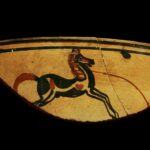Throughout human history, horses have symbolized power, speed, and nobility across diverse civilizations. Beyond their practical uses for transportation and warfare, these majestic animals held profound spiritual significance in many ancient societies. From the steppes of Central Asia to the temples of Greece, horses featured prominently in religious rituals, sacrifices, and mythologies. Their integration into sacred ceremonies reflected their exceptional status and the deep bond they shared with humans. This exploration of horses in ancient religious contexts reveals not only how our ancestors worshipped but also how they understood their relationship with these remarkable animals and the natural world.
The Sacred Bond: Horses as Divine Messengers

In numerous ancient traditions, horses were considered intermediaries between the human and divine realms. Their speed and power suggested an ability to traverse worlds, making them natural symbols for communication with deities. The Vedic traditions of ancient India portrayed horses as vehicles of the gods, particularly associated with Surya, the sun deity who rode across the sky in a chariot pulled by seven horses. Similarly, in Norse mythology, Odin’s eight-legged horse Sleipnir could journey between realms, including the land of the dead. This perception of horses as cosmic messengers influenced their treatment in religious ceremonies, where they were often adorned with special decorations signifying their sacred status. Their presence in rituals was believed to establish a direct line of communication with the divine, allowing prayers and offerings to reach their intended supernatural recipients.
Horse Sacrifices in Indo-European Traditions

Perhaps the most significant religious ceremony involving horses in ancient times was the horse sacrifice, particularly prominent in Indo-European cultures. The Ashvamedha in Vedic India represented one of the most elaborate forms of this practice, performed by kings to demonstrate their sovereignty and bring prosperity to their kingdoms. This year-long ritual involved releasing a specially chosen stallion to roam freely, followed by armies that challenged any ruler who attempted to stop the horse. Upon the horse’s return, it would participate in an elaborate ceremony before being sacrificed, symbolizing the king’s divine right to rule. Similar ceremonies existed among ancient Romans, Celts, and other Indo-European peoples, though details varied culturally. These sacrifices weren’t merely displays of power but reflected a complex cosmological understanding where the horse embodied vital cosmic forces.
Horses in Ancient Greek Religious Practices

The ancient Greeks integrated horses into their religious ceremonies in multiple ways that reflected their cultural values and mythological traditions. Poseidon, god of the sea, was also recognized as the creator of horses and honored through equestrian competitions during religious festivals. The Panathenaic Games featured prominent horse and chariot races dedicated to Athena, the patron goddess of Athens. Archaeological evidence from Greek sanctuaries has uncovered numerous horse figurines left as votive offerings to various deities, demonstrating the animal’s sacred associations. Perhaps most spectacularly, the Greeks occasionally made offerings of horses to water deities by drowning them in springs or the sea, believing these sacrifices would please gods associated with water and fertility. These practices illustrate how horses occupied a unique position in Greek religious thought, connecting athletic prowess with divine worship.
Scythian Horse Burials and Afterlife Beliefs

The nomadic Scythians of the Eurasian steppes demonstrated extraordinary devotion to horses in their religious practices, particularly in elaborate burial ceremonies. Archaeological excavations of Scythian kurgans (burial mounds) have revealed horses interred alongside human remains, often with spectacular golden ornaments and elaborate headgear. These horses were sacrificed to accompany their owners into the afterlife, reflecting a belief that the deceased would need their mounts in the next world. In some royal Scythian burials, dozens of horses were sacrificed and arranged in circular patterns around the central human burial, creating a dramatic statement about the ruler’s power and spiritual journey. The horses were frequently buried with their full riding equipment, including saddles, bridles decorated with gold and precious stones, and other accoutrements befitting their importance. This practice, spanning from the 7th century BCE to the 3rd century BCE, represents one of the most striking examples of the horse’s role in ancient funerary religion.
Chinese Horse Ceremonies and Imperial Worship

In ancient China, horses held significant religious and political importance, particularly during the Zhou and Han dynasties. Imperial ceremonies often featured white horses as symbols of purity and heavenly connection, with emperors performing sacrifices to heaven using these specially selected animals. The famous terracotta army of Emperor Qin Shi Huang included numerous cavalry horses, indicating their importance in concepts of power extending into the afterlife. Archaeological discoveries have revealed elaborate horse burials in which horses were sometimes sacrificed and buried with chariots to serve noblemen in the afterworld. The Han dynasty formalized celestial horse worship after General Zhang Qian’s famous journey west resulted in the acquisition of the “heavenly horses” of Ferghana, which were believed to sweat blood and possess supernatural qualities. These “celestial steeds” became objects of imperial cult worship, with ceremonial stables and caretakers dedicated to their maintenance and ritual use.
Celtic Horse Goddesses and Ritual Practices

The Celtic peoples of ancient Europe maintained complex religious relationships with horses, particularly through their association with powerful goddesses. Epona, whose name literally means “Divine Horse,” was worshipped throughout the Celtic and Gallo-Roman world as a protector of horses, riders, and a guardian of the passage between life and death. Archaeological evidence from Celtic religious sites has uncovered numerous horse figurines, jewelry, and ceremonial objects depicting horses that served as votive offerings. Celtic priests and priestesses sometimes performed divination rituals by observing the movements and behavior of sacred white horses kept in groves and temples. In Ireland, the medieval literature preserves accounts of ancient inauguration ceremonies for kings that involved ritual mating with a white mare (likely symbolic rather than literal), representing the sacred marriage between the ruler and the land goddess, followed by a feast that included horsemeat, establishing the king’s sovereignty through communion with the horse deity.
Norse Horse Rituals and Sleipnir Mythology

Norse religious traditions incorporated horses into various sacred contexts, from sacrificial ceremonies to mythological narratives. Archaeological evidence from sites like the temple at Uppsala in Sweden describes regular horse sacrifices during major religious festivals, with the animals’ blood collected and sprinkled on sacred trees and temple walls to ensure fertility. The consumption of horsemeat held religious significance in Norse rituals, becoming a point of contention during Christianization, as Christian missionaries often forbade this practice to break pagan traditions. Odin’s eight-legged horse Sleipnir featured prominently in Norse cosmology as the ultimate shamanic vehicle, capable of traveling between the nine worlds of their universe. Horse figureheads on Viking ships served both practical and religious functions, invoking protection from horse-associated deities during dangerous sea voyages. These practices demonstrate how horses in Norse religion embodied concepts of cosmic travel, fertility, and divine protection.
Persian Zoroastrian Horse Ceremonies

In ancient Persia, particularly under Zoroastrianism, horses held special religious significance connected to solar worship and divine kingship. The Achaemenid kings performed elaborate ceremonies involving white horses, which were considered sacred to Mithra, the deity of light and oaths. Historical accounts describe how Persian priests would lead specially groomed white horses in procession during major religious festivals, with the animals adorned in gold and purple trappings. Herodotus documented the Persian practice of including horses in funeral rites for fallen warriors, where horses would be groomed and then made to mourn by being led to view the body of their fallen rider. Archaeological evidence from Persepolis and other sites reveals horse imagery in religious contexts, often associated with royal authority and divine blessing. These practices reflected the Zoroastrian cosmological principle of the horse as representing good creation and its role in the cosmic battle between light and darkness.
Egyptian Horse Rituals and Solar Connections

Though horses were introduced relatively late to ancient Egyptian civilization, they quickly assumed religious significance, particularly in connection with solar deities and pharaonic power. During the New Kingdom period, horses became associated with the sun god Ra’s journey across the sky, sometimes depicted pulling the solar barque through the heavens. Ramesses II commissioned elaborate temples featuring horse imagery and dedicated stables for horses used in religious processions and ceremonies. Archaeological evidence from royal tombs has uncovered ceremonial horse burials, particularly in the Delta region, where horses were interred with elaborate harnesses and sometimes complete chariots. Temple inscriptions describe rituals in which specially selected horses would be presented before deity statues during festivals, receiving blessings before participating in ceremonial parades through sacred precincts. These practices integrated horses into Egypt’s elaborate religious system while maintaining their association with royal power and cosmic order.
Mesopotamian Horse Deities and Ceremonial Roles

In ancient Mesopotamia, horses gained religious significance after their introduction in the early second millennium BCE, becoming associated with both warfare and divine power. Cuneiform texts describe ceremonial roles for horses in temples dedicated to storm gods like Adad, where white horses were presented as offerings and participated in processional rituals. Archaeological evidence from sites like Mari and Nimrud has uncovered elaborate horse trappings used in religious ceremonies, including gold-decorated bridles and ceremonial frontlets. Assyrian kings conducted ritual hunts on horseback that held religious significance, demonstrating their divinely sanctioned dominion over nature while priests performed accompanying ceremonies. Divination practices sometimes involved observing the behavior of sacred horses kept in temple precincts, with their movements interpreted as omens from the gods regarding military campaigns or important state decisions. These practices illustrate how Mesopotamian cultures adapted their religious traditions to incorporate horses as they became integral to their civilization.
Native American Horse Ceremonies

Though horses were reintroduced to the Americas by European colonizers, many Native American tribes rapidly developed profound spiritual relationships with these animals, creating ceremonies that likely incorporated elements of pre-existing religious traditions. The Lakota Sioux performed the sacred Horse Dance ceremony, in which participants embodied the spirit of horses through dance and ritual to gain their power and understand their medicine. Among Plains tribes, horse medicine bundles contained sacred objects believed to channel the spiritual power of horses for healing, protection in battle, and success in horsemanship. The Nez Perce, renowned for their selective breeding of the Appaloosa horse, incorporated horses into their annual ceremonies with special dances and blessings that honored the spiritual connection between humans and horses. These ceremonies often included ritual painting of horses with symbols representing spiritual protection, speed, and power, transforming the animals into living embodiments of sacred forces. While these traditions developed after European contact, they demonstrate the universal tendency to incorporate horses into spiritual frameworks across human cultures.
Modern Echoes of Ancient Horse Ceremonies

Vestiges of ancient horse ceremonies persist in various cultural traditions around the world today, demonstrating the enduring spiritual significance of the human-horse relationship. In Mongolia, the Naadam festival features horse racing with ritual elements that echo ancient steppe traditions, including ceremonial offerings of fermented mare’s milk to the sky deities before competitions. Spain’s Andalusian region preserves horse festivals with religious components, such as the Romería del Rocío pilgrimage where elaborately decorated horses and their riders travel to honor the Virgin Mary, combining Christian and older pagan elements. In parts of India, decorated horses still feature in wedding ceremonies and religious processions, reflecting ancient Vedic traditions that considered horses auspicious and spiritually powerful. Even modern equestrian sports contain vestigial ceremonial elements, from the formal dress of dressage to the ritual presentation of trophies and garlands that echo ancient prize ceremonies at religious festivals. These contemporary practices demonstrate how the spiritual significance of horses has evolved but never disappeared from human cultural and religious expression.
Conclusion

Throughout human history, horses have occupied a unique position at the intersection of practical utility and spiritual significance. Their integration into religious ceremonies across diverse ancient cultures reflects both their practical importance and their symbolic power in human imagination. From elaborate sacrifices to divine representation, horses helped our ancestors conceptualize their relationship with supernatural forces and the cosmos. The widespread nature of horse veneration across unrelated cultures suggests something intrinsic in the human-horse relationship that naturally lends itself to spiritual interpretation. By understanding how our ancestors incorporated horses into their most sacred practices, we gain insight not only into their religious beliefs but also into the deep psychological and emotional bonds that have connected humans and horses across millennia—connections that continue to resonate in various forms today.







